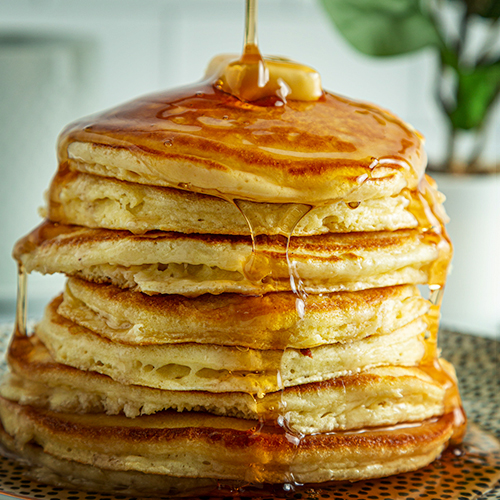How to Perfectly Flip a Pancake
What’s for breakfast? If it’s golden, fluffy, wonderful pancakes (we hope so!), then you’re going to want to check out this quick reference guide on how to flip a pancake. As passionate pancake connoisseurs, we at Kulick’s Pancake Recipes are on a mission to help the world enjoy the pancakes of their dreams each and every time. So without further ado, let’s explore how to make the perfect pancake:

In addition to our pancake flipping infographic, we want to serve up a few more morsels of knowledge on how to make perfect pancakes every time. Here are solutions to some of the most common pancake mistakes, pancake flipping tips, and more to help you achieve perfect pancakes that are fluffy, golden, and delightful.
How Long Should Pancake Batter Rest?
A resting period of at least five minutes (and up to 30 minutes) can contribute to a soft, tender texture. There is science behind resting pancake batter, as with all cooking; the gluten in the dough has time to relax so the starch can absorb moisture consistently.
Do You Cook Pancakes on High or Low Heat?
Neither! Cooking pancakes on medium-low to medium can deliver a lovely golden brown color without burning. Achieve the right temperature before applying the batter; do not pour batter onto a cold pan. You should see steam emanating from the surface of the pan, not smoke. Cooking pancakes on too low of a heat setting will yield a tough texture, but too much heat will burn them. For griddles, the optimal temperature is 375°F.
How Do I Know When to Flip a Pancake?
Many believe that the right time to flip a pancake is when bubbles begin to form, but patience is key! Wait until bubbles have formed throughout the pancake, not just around the edges. The bubbles should form, pop, and leave holes that stay open on the surface of the pancake — that’s the perfect time to flip a pancake. If bubbles form but fill up quickly with more pancake batter, hold off.
Why Are My Pancakes Flat?
A flat pancake may be the result of overly wet batter. What should pancake batter look like? The perfect pancake batter should be slightly lumpy and should be thick enough to drip off the spoon rather than pour off. If the pancake batter is too thick, add a tablespoon of milk at a time to achieve the right consistency. If the pancake batter is too runny, try adding a bit of flour. If that does not help, the problem could be stale baking powder. Test the freshness of your baking powder by splashing a spoonful with warm water; the baking powder should bubble or fizz gently.
How Do You Fix Gooey Pancakes?
Gooey, chewy, or gummy pancakes may be caused by overmixing the batter, which toughens up the gluten. When mixing, make sure to gently fold in the ingredients and avoid overdoing it.
How to Perfectly Flip a Pancake
| Step | Explanation |
| Step 1: Use the right kind of pan. | Use a flat, nonstick griddle. This allows you to get the spatula anywhere around the pancake to assist with the flip. |
| Step 2: The right temperature is key to success. | Cooking the pancakes on medium-low gives a lovely golden-brown color without burning them before they are ready to flip. Give the pan time to heat evenly before applying the batter. |
| Step 3: Greasing the pan can smooth the process. | Melt a dollop of butter on the pan before pouring the batter onto it, then add another small dollop after the flip to create a nice butter-browned exterior.
Butter or oil can help you make sure the pan is the right temperature, too. It should be very hot but not smoking. |
| Step 4: Use the right spatula. | Use a large but thin turner spatula that can fit all or almost of the pancake to ensure a clean flip. |
| Step 5: Look for bubbles throughout to know when to flip. | The right time to flip is when the batter has bubbles forming throughout, not just around the edges. The bottom will also appear golden-brown, and the rim will be formed. Depending on the batter and pancake size, this will take around 2 to 3 minutes. |
| Step 6: Cook on the other side for an additional minute or so. | After the flip, cook for another minute or so to make sure the pancake is fully cooked. |
More Pancake Cooking Tips
- Practice flipping smaller, plain pancakes first to get the hang of it. Then, you can try ones with fun fillings.
- Do not press the pancakes into the pan. This presses the air out, causing them to become dense and chewy.
- Avoid the urge to overmix the batter. It’s tempting to mix until the batter is perfectly smooth, but this can cause tough and chewy pancakes due to gluten forming. Mix just until the wet and dry ingredients combine and there is no visible flour. It may be lumpy, but that’s OK.
Related: Crispy Pancake Recipe, and Classic Pancake Recipe with No Egg
Use the following embed code to post this infographic on your website:
This page was last updated by Bruce Kulick and Lisa Lane Kulick






